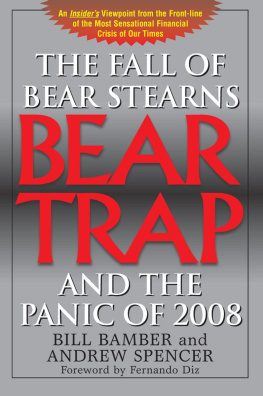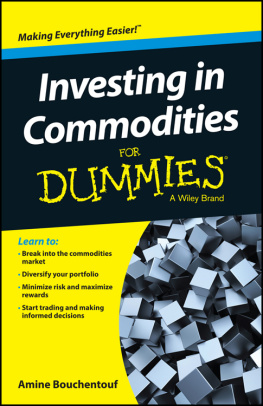Table of Contents
In memory of my parents, Miles Waggoner and
Dorothy Mundinger, and with love for my children,
Nate and Hope Waggoner
Acknowledgments
First, Id like to thank Debra Englander, my editor, and Kelly OConnor, Wileys development editor, for their support and great patience.
When you work in a newsroom, anything you do is often the result of your interactions with your fellow reporters and editors. Sandra Block, Christine Dugas, and Cathy Chu are friends of the best kind:They can tell you when your ideas are good and when theyre bad, and in either case, you still wind up laughing about it. I can always talk about the markets with David Craig, Matt Krantz, and Adam Shell, and I always come away with help and encouragement. Nancy Blair, Fred Monyak, and Tom Fogarty can make me look much better than I am and they do it with grace. The folks who run the Money sectionJim Henderson, Geri Tucker, and Rodney Brooksare one reason its so consistently good. And Mary Ann Cristianos love, encouragement, and patience helped me more than I can possibly say.
Chapter 1
What Just Happened Here?
If you have ever woken up in the lemur cage at the zooand who hasnt?you know that most true disasters start innocently enough. In this case, it all started with a night out with your buddies. You drank. You talked. You ordered a martini. It tasted good.
Pretty soon, someone suggested moving to Snickenfelders, where they have a list of martinis longer than the menu. Good idea! After all, Snickenfelders was just down the street. And when you got there, you were confronted with more alcoholic concoctions than you thought possible. You tried an apricot mango martini. Yum. An orange chocolate martini. Wow. On reflection, your mistake was ordering the Snickenfelder Schnocker, made with vodka, hazelnut liquor, amaretto, Irish cream, Kahlua, and more vodka.
You vaguely recall the karaoke contest, but you have to admit that you probably did not understand the rules when you got up on the stage. Unbroken Melody was probably a bad choice, given your state. At any rate, here you are, covered in peanut butter and surrounded by cooing primates.
In March of 2008, the world markets woke up with one of the ugliest hangovers in history. Bear Stearns, the fifth-largest U.S. investment bank found itself in the financial equivalent of the drunk tank: Sequestered with federal regulators and pitiless bidders for the remnants of its assets.
It was a nasty, nasty, bender that put Bear Stearns in the lockup, the sort of sudden decline that smacks of Victorian morality tales. Just two years earlier, Bear Stearns was a titan of finance, happily ensconced at its massive $1.3 billion headquarters at 383 Madison Avenue in New York. It had thousands of employees working around the globe, billions of dollars in assets, and a varied business in stocks, bonds, derivatives, and financial counseling for the very rich.
In short, Bear Stearns was a very big, very important company, one with tremendous earnings and global clout. And Bear Stearns remained a very big, very important company right up until the second week of March, 2008. On March 7, 2008, the companys stock closed at $70.08well off its 2007 highs, but nearly every financial stock had been clobbered in 2008.
The next trading day, Monday, March 10, the stock slid more than 10 percent and closed at $62.30. Tuesday, it fell to $55. After a slight rally on the 12th, it slipped below $60 again. Then, on Friday, the stock collapsed, plunging to $30 a share. But the worst was yet to come.
Late on Sunday, March 16, word came out that arch rival JPMorgan Chase had bid just $2 a share for Bear Stearns, and the company had accepted it. By the end of trading on March 17, 2008, Bear Stock was trading at $4.81 a share.The $2 price tag was just too low for Wall Street to believeand rightly so, as it turned out.
JP Morgan Bags Wounded BearBargain-basement $235 million for Reeling Giant, read the March 17 headline of the New York Post. JPMorgan Chase bought all of Bear Stearns for about a fifth of the value of its Manhattan headquarters alone. Later that week, bowing to threats of lawsuits, JPMorgan Chase upped the Bear bid to $10 a sharestill, on its face, a tremendous bargain.
By the end of the Bear Stearns saga, there were plenty of ruined investors. Employees who had kept money in Bear Stearns stock were essentially wiped out. (Top management, who had many more shares, fared far better than the rank and file). But big companies fail all the time and, to be honest, they leave little mark of their passage, except for the holes they leave in the lives (and retirement accounts) of their workers.
When Bear Stearns collapsed, however, it nearly crippled the short-term money market, the lifeblood of modern finance. Bank lending ground to a halt. Municipal financing, which pays for roads, schools, and other daily essentials, evaporated. The companys fall changed the way the government regulates Wall Street, and it shook the faith of investors to the coreand justifiably so.
The Herd on the Street
How did it happen?
Periods of intoxication generally begin with sobriety, and it is the nature of manias that they start out perfectly sane. So we are going to detail, in the next chapter, the relatively sober beginnings of the bubble that eventually bagged Bear. As you will see, things made a great deal of sense.
From 2005 until August, 2007 was the period of pure mania. Most of us are familiar with the boom in housing, but it is still interesting to recap, if only for sheer, eye-popping detail and shadenfreude. We will visit a small, somewhat representative town in suburban Washington to illustrate what soaring house prices can do to otherwise sober citizens.
But the real bubblethe one that took down Bear Stearnswasnt in the real estate market. It was in the debt market. We think of bonds as a kind of investment for Old Money, the folks who would visit the bank vault every few months, clip a few coupons, and redeem them for walking-around money.
In fact, the bond bulls had run on Wall Street for a very, very long time.The bull market in stocks ran from August 1982 and ended (according to some views) in March, 2002, propelling the Dow up about 1,200 percent. (See .)
The Super Bull Market in Stocks, 1982-2000
But the bull market in bonds ran far longer.We will explain this in detail in Chapter 3, but bonds prices rise when interest rates fall. The yield on the bellwether 10-year Treasury bond fell from a high of 15.83 percent in September 1981 to a low of 3.35 percent in May 2003. For the past 10 years, you would have made far more money investing in bonds than you would have investing in stocks. (See .)
We havent seen a bear market for bonds in many, many yearsand what brought down Bear Stearns was not the stock market, but the bond market. Bear Stearns nearly went bankrupt because the bonds it packaged and sold to investors were so incredibly bad. Eventually, Bears creditors suspected that the companys assets were virtually worthlessand lending to a company with worthless assets is simply throwing good money after bad. At the very end, when Bear Stearns could not even get short-term lending, the company was forced to a great reckoning in a small roomthe sale of itself for the fire-sale price of $2 a share to JPMorgan Chase.















